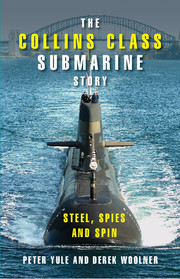Book contents
- Frontmatter
- Contents
- List of key people
- List of acronyms
- Introduction
- Part 1 You Can't Build Submarines in Australia
- Part 2 The Honeymoon Years 1987–92
- Part 3 ‘A Strange Sense of Unease” 1993–98
- Part 4 Resolution
- 22 ‘Hardly a day went by without the project getting a hammering in the press’: the project in crisis 1997–98
- 23 ‘Bayoneting the wounded’: the McIntosh-Prescott report
- 24 ‘That villain Briggs’ and the submarine ‘get-well’ program
- 25 ‘Inside the American tent’: the saga of the replacement combat system
- 26 ‘We'll do it and get rid of the buggers’: Kockums, ASC and Electric Boat
- 27 ‘We would find that challenging’: comparison and retrospect
- Notes
- Index
23 - ‘Bayoneting the wounded’: the McIntosh-Prescott report
Published online by Cambridge University Press: 05 September 2013
- Frontmatter
- Contents
- List of key people
- List of acronyms
- Introduction
- Part 1 You Can't Build Submarines in Australia
- Part 2 The Honeymoon Years 1987–92
- Part 3 ‘A Strange Sense of Unease” 1993–98
- Part 4 Resolution
- 22 ‘Hardly a day went by without the project getting a hammering in the press’: the project in crisis 1997–98
- 23 ‘Bayoneting the wounded’: the McIntosh-Prescott report
- 24 ‘That villain Briggs’ and the submarine ‘get-well’ program
- 25 ‘Inside the American tent’: the saga of the replacement combat system
- 26 ‘We'll do it and get rid of the buggers’: Kockums, ASC and Electric Boat
- 27 ‘We would find that challenging’: comparison and retrospect
- Notes
- Index
Summary
John Moore was a successful stockbroker, long-time strong man of the Queensland Liberal Party and Minister for Industry in the first Howard government from 1996 to 1998. The submarine project was not then in his bailiwick, but he thought ‘it had all the signs of a project that was out of control’. After the federal election of October 1998 he became Minister for Defence, expecting that this would be his last portfolio before he retired from politics. He was appalled by what he saw as the unbusinesslike management of the Defence Ministry and soon came to the conclusion that ‘no financial figures from defence are correct’. In his first year the books were not within $700 million and he asked a senior official what he should do. ‘Just write it off’, he was told. Every defence project was over time and over budget and he was given lists of overruns to approve as a matter of routine. He was continually asked to allocate more money and told that it would not affect the budget. The department had three different accounting systems running more than 60 computer programs, with innumerable consultants working on them. He was disappointed with the management abilities of senior military leaders and felt that the policy of short rotations meant that few of them had a firm grasp on their jobs.
The military seemed to have the attitude that the minister's role was to get money from the parliament and then leave them to spend it free of supervision or control. The navy in particular, he felt, had ‘a delightful indifference to government’.
- Type
- Chapter
- Information
- The Collins Class Submarine StorySteel, Spies and Spin, pp. 274 - 286Publisher: Cambridge University PressPrint publication year: 2008



